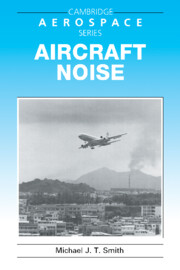Book contents
- Frontmatter
- Contents
- Preface
- Acknowledgments
- 1 Human reaction to aircraft noise
- 2 Action against aircraft noise
- 3 Aircraft noise sources
- 4 Power-plant noise control
- 5 Concorde – a special case
- 6 Noise data acquisition and presentation
- 7 Aircraft noise prediction
- 8 Prospects for the future
- 9 Review
- Appendices
- References
- Index
6 - Noise data acquisition and presentation
Published online by Cambridge University Press: 06 November 2009
- Frontmatter
- Contents
- Preface
- Acknowledgments
- 1 Human reaction to aircraft noise
- 2 Action against aircraft noise
- 3 Aircraft noise sources
- 4 Power-plant noise control
- 5 Concorde – a special case
- 6 Noise data acquisition and presentation
- 7 Aircraft noise prediction
- 8 Prospects for the future
- 9 Review
- Appendices
- References
- Index
Summary
Aircraft noise and related data are acquired for a multitude of purposes but, broadly speaking, they fall into two categories – those for public presentation and those for research experiments. The method of measurement and the systems involved in processing data for public consumption are normally closely controlled, with a range of specifications determining the instrumentation system standards and the way in which data are acquired and analysed. The most rigid form of measurement control occurs in noise certification. Since the certifying authority does not itself conduct aircraft noise tests, it is the task of the aircraft manufacturer to comply with all the requirements and present the information in a standard form. The equipment and provisions made by the manufacturer are closely scrutinised by the authority for compliance before and during the tests.
The formulation of certification specifications has been a monumental and evolving task that has been going on for the best part of two decades and it is still unfinished owing to the continually changing state of the art. Many thousands of man-hours have been consumed in the task of refining international standards, with the important objective of reducing the variability of results obtained by different organisations that use different equipment and operate in different climatic conditions around the world. The necessity for such stringent specifications is now being amply justified as aircraft noise requirements at the national and local level creep ever closer to industry's capabilities.
- Type
- Chapter
- Information
- Aircraft Noise , pp. 176 - 226Publisher: Cambridge University PressPrint publication year: 1989



